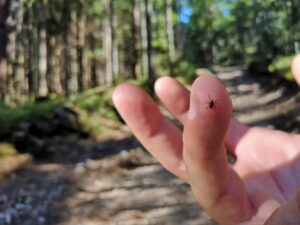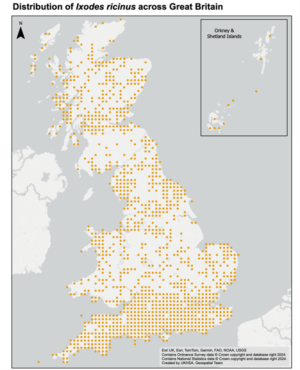Tick Borne disease in the UK
With the change in climate conditions and increasing global warming, TBE is now found in the forested areas of the UK.

Originally Tick Borne Encephalitis (TBE) was considered a disease of risk in areas of Western and northern Europe, extending to the northern and eastern areas of Asia. With the change in climate conditions and increasing global warming these traditional areas have now extended to include the UK.
Most infections come from tick bites acquired in forested areas from people cycling, bird watching, camping, fishing, hiking or collecting flowers, berries and mushrooms. This disease is not to be confused with Lyme disease which is tick borne but a bacterial infection for which treatment can be given.
Most cases of TBE occur between April and November and the number of reported human cases may not be a reliable predictor of the risk of infection. The virus is spread by a species of tick named Ixodes Ricinus, and the concentration of infected ticks is increased in areas where small rodents are present. People can also acquire TBE by eating or drinking unpasteurized dairy products such as cheese and milk, so avoidance of these products is recommended.
Recently the UK Health Security Agency (UKHSA) have published the Tick Surveillance map for 2023. This map shows the distribution of the tick Ixodes Ricinus across Great Britain. The tick has a wide distribution from southern England up to northern Scotland including the offshore islands of Wales and Scotland.
Although not present everywhere, the map shows greater coverage of presence records across all areas of southern England below a line from the Severn to the Thames, with areas of tick presence in East Anglia, North Yorkshire Moors, the Lake District and North Wales. In Scotland, the tick is present is most of the Highland Glens, as well as part of Galloway and the Outer Hebrides.
The absence of records does not necessarily mean the tick is absent.

So, the question is how to prevent it the infection. This starts with the use insect repellents containing an active ingredient on the WHO list:
- DEET
- Icaridin or picaridin
- Oil of Lemon Eucalyptus (OLE).
Other traditional repellents such as citronella oil, tea tree oil, vitamin B etc have no proven effectiveness or protection against ticks. The effective preparations need to be applied before entering the rural areas and routinely reapplied when in them for several hours.
In some cases where regular or routine exposure may occur then a course of TBE vaccinations can be considered from one of the CityDoc clinics or pharmacies. This a course of 3 vaccinations but will last for several years before a single booster dose is required.
Written by Derek Evans FFTM RCPS(Glasgow), FISTM, FRPharmS, FRGS
Travel Health and Vaccination Lead



